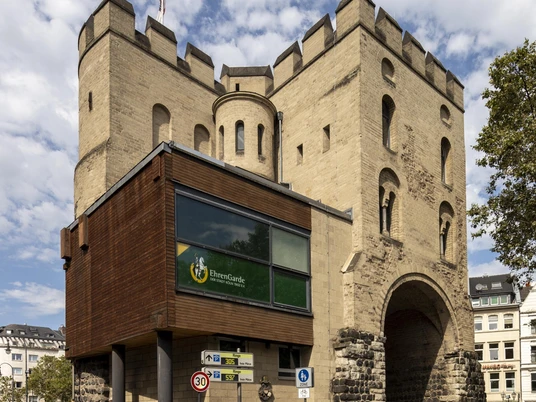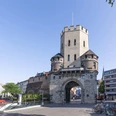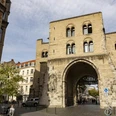- Photos & Map
How would you like to arrive?
- Details
- Useful Information
- Nearby
Imagine standing in a place that has welcomed people for centuries. Where merchants once pushed their carts filled with exotic goods through the gate, and knights in shining armor entered the city, modern Cologne now pulses. The Hahnen City Gate, a relic of medieval urban culture, tells of an era when city walls offered not only protection but also formed the identity of a city. Those who pass through its imposing arches move through a piece of history – a structure that has survived over 750 years of urban transformation.
Today, the Hahnen City Gate at Rudolfplatz serves as the historical counterpart to an ever-changing urban space that never forgets its roots. Once one of twelve original gate towers in Cologne’s eight-kilometer-long city wall, it secured the city's western entry on the road to Aachen and Jülich.
Even today, the surviving gate towers convey an impression of the former grandeur of the city wall. The medieval city gates served as protection, thresholds, and representation, places of encounter and control.
All gate towers are integral parts of an urban space that moves between tradition and modernity. Their central location makes them exciting starting points for your explorations, connecting the medieval heritage of Cologne with the vibrant life of the present.
Today, the Hahnen City Gate at Rudolfplatz serves as the historical counterpart to an ever-changing urban space that never forgets its roots. Once one of twelve original gate towers in Cologne’s eight-kilometer-long city wall, it secured the city's western entry on the road to Aachen and Jülich.
Hahnen City Gate in Historical View
The Hahnen City Gate received its first historical mention in 1264 as "nova porta." In medieval times, after coronation ceremonies in Aachen, kings would enter the city through this gate to proceed to Cologne Cathedral. The name of the gate either derives from "Hageno von Anselm," a landowner from the 12th century, or from the word "Hano," meaning wooden gate, due to the forests along the road to Aachen. Listed as "Hanenpforts," it appears in the "Cologne city view of 1570," the Mercator plan from cartographer Arnold Mercator. It became known as "Hahnen-Pforte" in 1812. One of Hahnen City Gate’s semi-towers was largely destroyed during WWII.Highlights, Freshly Picked
From over 750 years of history, only a few significant events stand out. For instance, the 12-year-old Ennchen Linnartz, the last burned witch, passed through the Hahnentor to the execution site at Melaten in 1655. In 1795, the Hahnentor received the number 5283 ½. Why ½? To denote a public and therefore tax-exempt building. In 1804, Empress Josephine entered Cologne through the Hahnentor. In 1814, the last of the French troops left Cologne through the Hahnentor before Cologne became part of the Prussian Rhine Province. The Kölnischer Kunstverein moved in in 1946, hosting exhibitions for the first time. 1996 saw partial renovations of the outer walls, the bridge adjoining the gate was renovated and redesigned in 2001, and outdoor lighting was installed in 2002. Major renovations were undertaken in 2007. In 2012, the Hahnen City Gate was featured as a Beagle Boys’ headquarters in Mickey Mouse Magazine. Until 2016, the EhrenGarde, Cologne's largest carnival society, had its headquarters here.Twelve Gate Towers of Cologne, Protecting the City
The historical gate towers of Cologne—constructed in the 12th and 13th centuries—were part of an impressive city wall that not only protected Cologne from attacks but also shaped its identity as one of Europe's major trade metropolises. It controlled the entry of traders, travelers, and pilgrims, as well as the flow of ideas, goods, and cultures.Even today, the surviving gate towers convey an impression of the former grandeur of the city wall. The medieval city gates served as protection, thresholds, and representation, places of encounter and control.
Four Gate Towers Remain
With the demolition of large parts of the city fortifications in the 19th century, only four of Cologne’s gate towers remain today—besides the Hahnen City Gate, there is the identical Eigelstein City Gate at Eigelstein near Ebertplatz, the Severins City Gate in the heart of the Severin quarter, and the Ulrepforte at Sachsenring in the Altstadt-Süd.All gate towers are integral parts of an urban space that moves between tradition and modernity. Their central location makes them exciting starting points for your explorations, connecting the medieval heritage of Cologne with the vibrant life of the present.
Useful Information
Eligibility
Suitable for any weather
for Groups
for Class
for families
for individual guests
Pet allowed
Suitable for the Elderly
Payment methods
Entrance Free
Parking facilities
The Hahnentorburg is located on Rudolfplatz at the western end of Cologne's city centre. Rudolfplatz has a metro and tram station of the same name. Several Cologne public transport lines (underground lines 12 and 15 and tram lines 1 and 7) intersect here, but buses (lines 136 and 146) also stop at Rudolfplatz. There are also multi-storey car parks in the immediate vicinity which can be used for those arriving by car.
Our recommendations
Nearby




